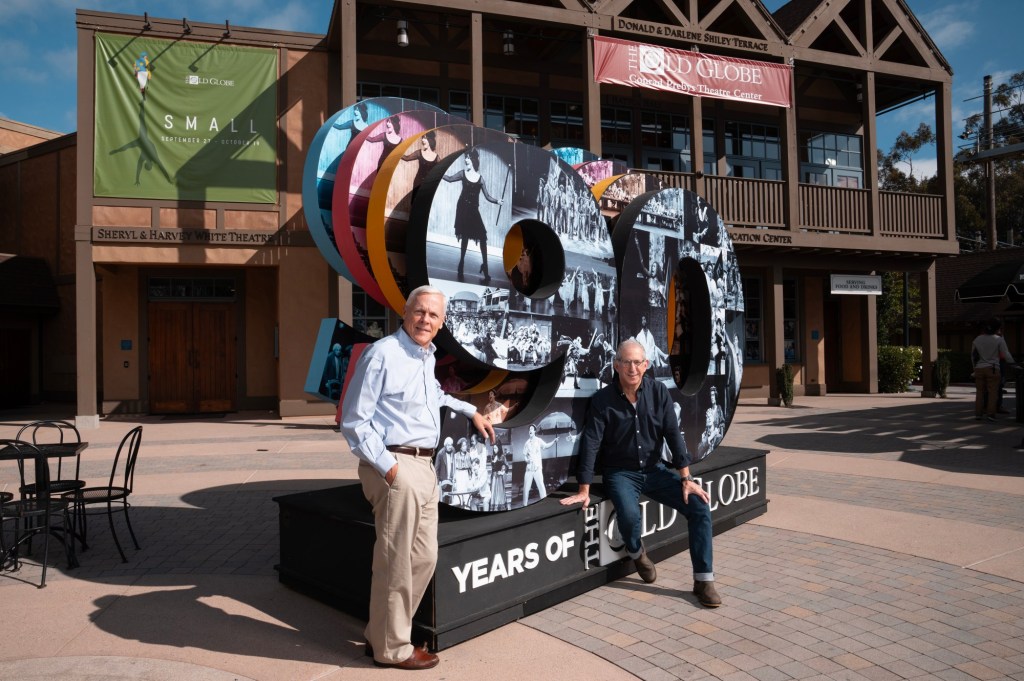On the afternoon of May 29, 1935, The “merrie England”-style, open-air Globe Theater welcomed its first audience for a performance of William Shakespeare’s “The Taming of the Shrew” at the California Pacific International Exhibition in San Diego’s Balboa Park.
In the next morning’s San Diego Union, theater critic Wallace Moody wrote that the crowd was “thrilled” by “Shrew” and several other 50-minute versions of Shakespeare plays, “all of them shorn of a great deal of verbiage, which sometimes makes tedious listening to modern ears.”
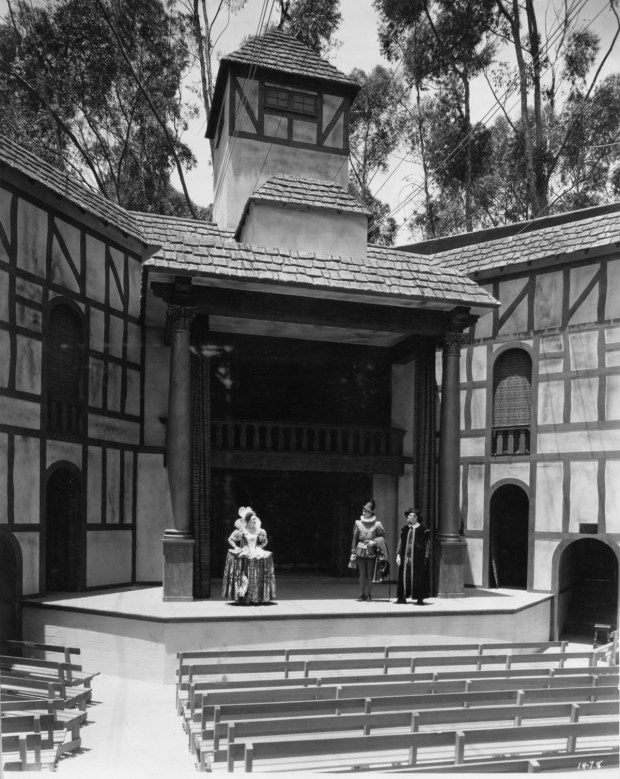 Actors on The Globe Theatre stage in Balboa Park in 1935. (The Old Globe)
Actors on The Globe Theatre stage in Balboa Park in 1935. (The Old Globe)
Ninety years later, The Old Globe carries on as one of San Diego’s most-cherished cultural jewels, and its commitment to the works of Shakespeare remains at the heart of its mission.
But the amateur theatrics of yesteryear are long gone. And thanks to generations of Globe audience members who have grown up listening the Bard’s words on its outdoor stage, San Diegans’ “modern ears” no longer need stripped-down scripts to be thrilled.
Today, the Globe is thriving as San Diego’s oldest and largest theater organization, offering both ticketed and free performances to musicals, plays, Shakespeare and engagement events for more than 250,000 people a year.
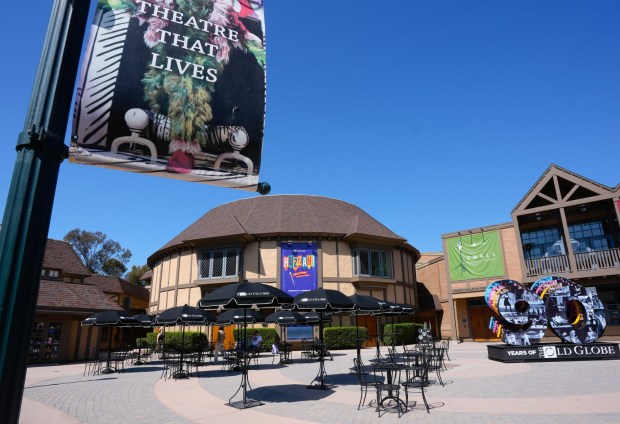 The Old Globe Campus. (Nelvin C. Cepeda / The San Diego Union-Tribune)
The Old Globe Campus. (Nelvin C. Cepeda / The San Diego Union-Tribune)
With a $40 million annual institutional budget, the Globe is San Diego County’s second-largest arts organization, behind the San Diego Symphony, which has a $49 million budget this year. And, with a combined 16 shows presented on its three stages each year, the Globe is believed to be the largest nonprofit theater in America outside of New York City, according to company officials.
The Globe has a full-time year-round staff of 120, which doubles in size seasonally when in full production. There are also some 2,000 volunteers and up to 800 part-time workers throughout the year.
In celebration of the Globe’s 90th anniversary, we spoke with its leaders, present and past, about the company’s legacy, and some of the goals in mind for the theater’s centennial in 2035. But first, let’s talk about the Globe’s beginnings.
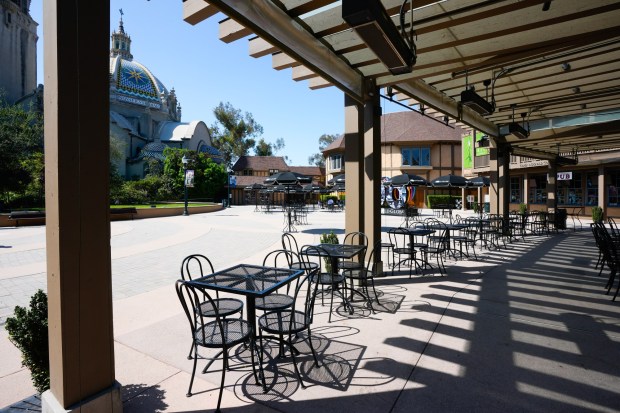 The Old Globe Campus. (Nelvin C. Cepeda / The San Diego Union-Tribune)
The Old Globe Campus. (Nelvin C. Cepeda / The San Diego Union-Tribune)
Building and growing
The Globe Theater closed after the 1936 California Pacific International Exhibition, but public enthusiasm for the Balboa Park venue led the city to renovate the building by adding a roof so it could be used year-round by a community theater troupe. It reopened in 1937 as The Old Globe Theatre, and within three years, one of its busiest actor-directors, Craig Noel, was named founding director.
Old Globe Artistic Director Barry Edelstein, who celebrates his 13th year in the job this month, said he’s always been charmed by the “wonderful homespun Americana” stories from the Globe’s low-budget early days, like when volunteers would bring homemade sandwiches to the park to feed the hungry actors.
But the Globe history is one of steady and successful growth. By the late 1950s, Noel was able to turn The Old Globe into a professional theater company, with Equity actors hired year-round.
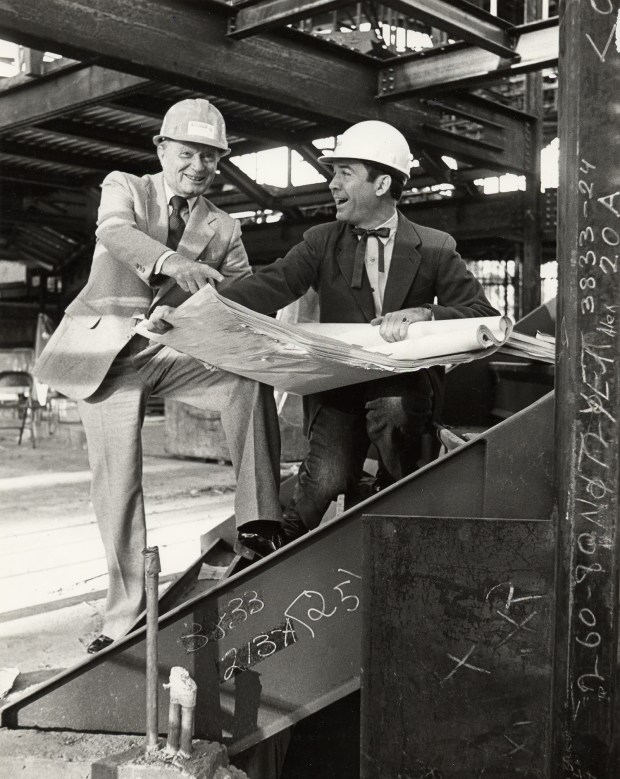 Old Globe artistic director Craig Noel, left, and future artistic director Jack O’Brien during the rebuilding of The Old Globe following an arson fire in March 1978. (The Old Globe)
Old Globe artistic director Craig Noel, left, and future artistic director Jack O’Brien during the rebuilding of The Old Globe following an arson fire in March 1978. (The Old Globe)
Then in the mid-1980s, Noel’s successor, Artistic Director Jack O’Brien, led the Globe to a great leap forward by sending its world premiere musical “Into the Woods” to Broadway. Since then, 26 more Globe-born plays and musicals have made the Broadway jump.
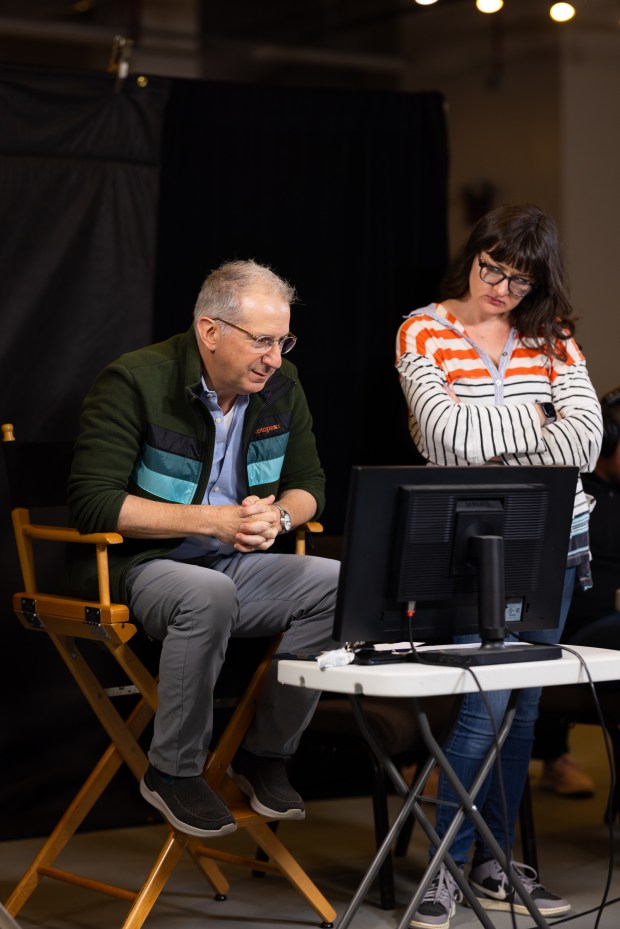 The Old Globe artistic director Barry Edelstein, left, and projection designer Caite Hevner during rehearsals for The Old Globe’s “Henry 6” in 2024. The two-play adaptation of William Shakespeare’s “Henry VI” plays was written by and directed by Edelstein. (Rich Soublet II)
The Old Globe artistic director Barry Edelstein, left, and projection designer Caite Hevner during rehearsals for The Old Globe’s “Henry 6” in 2024. The two-play adaptation of William Shakespeare’s “Henry VI” plays was written by and directed by Edelstein. (Rich Soublet II)
Edelstein’s arrival at the Globe in fall 2012 ushered in another era of significant growth in expanded community engagement. Through the education and community outreach efforts he spearheaded, more than 30,000 people are now being served each year free of charge.
During the pandemic, the Globe carried on with hundreds of hours of online programming and classes. And one of the Globe’s biggest-ever community-interaction projects was the summer 2024 production of “Henry 6,” where more than 1,000 San Diegans contributed to what ended up onstage.
Here’s a look at some of the theater’s lasting legacies.
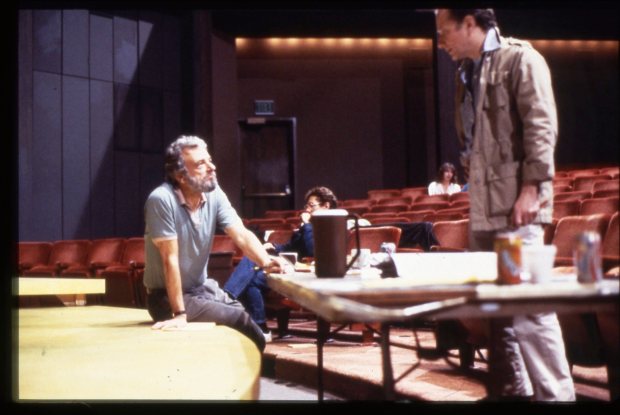 Composer and lyricist Stephen Sondheim, left, and bookwriter/director James Lapine in rehearsals at The Old Globe for the world premiere of the musical “Into the Woods in 1986. (J. P. Weiss)
Composer and lyricist Stephen Sondheim, left, and bookwriter/director James Lapine in rehearsals at The Old Globe for the world premiere of the musical “Into the Woods in 1986. (J. P. Weiss)
The Broadway pipeline
In a phone interview last week from his home in Connecticut, Jack O’Brien said it wasn’t production money or “sun dollars” (meaning balmy weather) that brought composer/lyricist Stephen Sondheim and bookwriter James Lapine to the Old Globe in 1986 to launch their fairy-tale musical “Into the Woods.” It was the Globe’s distance from New York and its snooping theater critics.
“They wanted freedom and privacy to create,” O’Brien said of Sondheim and Lapine. “They wanted the luxury of going somewhere that was too far to just get on the highway and drive over. The whole Eastern Seaboard had been that route of trying out shows for many decades. Nobody at that point was really willing to get on a plane and come across the entire country.”
When “Into the Woods” opened on Broadway the following year and won multiple Tony and Drama Desk Awards, The Globe (and, later, La Jolla Playhouse) became fertile ground for new work.
“There was a moment in time when everything pivoted. When Sondheim and James (Lapine) came west, the entire landscape shifted,” O’Brien said. “Up to that point, we took what was out there and we redid it, we inherited it or we followed. But when they wanted to come to the Globe and create something, the entire regional market changed almost overnight. We were no longer the hinterlands. We were a development tool for theater in a way that we’d never proved ourselves.”
Edelstein said O’Brien created one of the Globe’s greatest legacies for theatrical innovation.
“I have to tip my hat to Jack O’Brien,” Edelstein said. “The decade-by-decade professionalization of the place has brought us to a point that we are one of the focal institutions for the development of new work. The national level of artistry is central to the place, making San Diego one of the best theater towns in the country … The center of gravity has shifted to this place.”
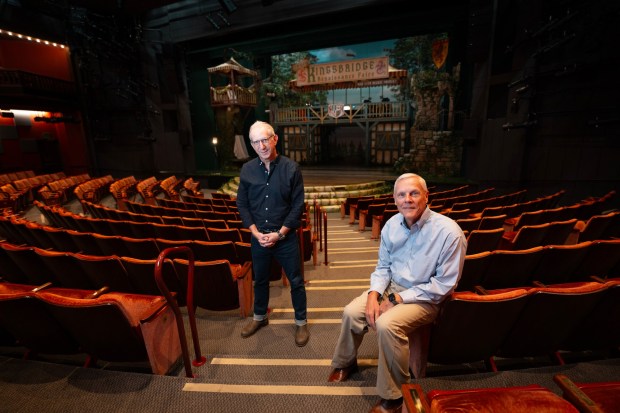 Old Globe Artistic Director Barry Edelstein (l) and Old Globe Managing Director Tim Shields (r) at the Old Globe on Friday, Oct. 3, 2025 in San Diego, CA. (Nelvin C. Cepeda / The San Diego Union-Tribune)
Old Globe Artistic Director Barry Edelstein (l) and Old Globe Managing Director Tim Shields (r) at the Old Globe on Friday, Oct. 3, 2025 in San Diego, CA. (Nelvin C. Cepeda / The San Diego Union-Tribune)
Building community
For nine decades, people from all over San Diego and the world have come to The Old Globe for entertainment. But for more than 50 years, the Globe has been stretching its arms out into the community, as well.
“While the Globe has always had its gaze focused outward on San Diego, we’ve build a real infrastructure to sustain that,” Edelstein said. “It’s quite unique nationally. We’re very proud of that because the Globe’s slogan is ‘Theatre that lives beyond the stage.’”
In the 1970s, Noel began working with local theater artists to help build San Diego’s then-blossoming theater community. He offered directing and production tips, lent out equipment, offered performance space and served as an enthusiastic booster for many fledgling theater companies, including San Ysidro’s Teatro Máscara Mágica.
In the 1980s, Noel also collaborated with San Diego teachers to create Teatro Meta, a bilingual in-schools theater program. And in 1987, the Globe teamed with the University of San Diego to creat the Shiley Graduate Theatre Program on the USD campus.
As the Globe outgrew its Balboa Park facilities in the early 2000s, it relocated some of its technical departments and jobs to Southeast San Diego.
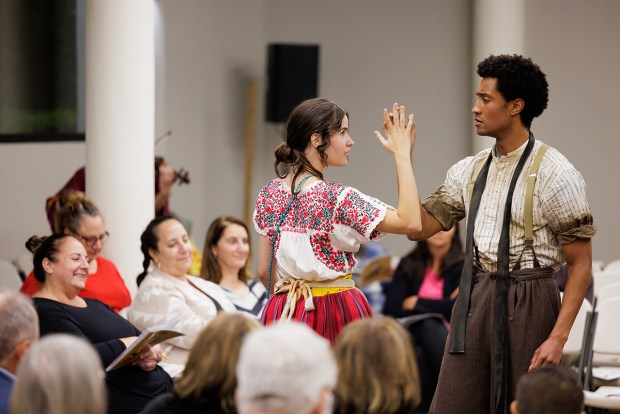 Actors Luana Fontes, left, and Vandous Stripling II perform “As You Like It” at a San Diego community center for The Old Globe’s 2024 Globe for All tour. (Rich Soublet II)
Actors Luana Fontes, left, and Vandous Stripling II perform “As You Like It” at a San Diego community center for The Old Globe’s 2024 Globe for All tour. (Rich Soublet II)
In 2014, the Globe launched its Globe for All program, which each fall brings free Shakespeare performances out into the community, including senior centers, gyms, refugee community centers, military installations and correctional facilities.
In recent years, the Globe has become a cultural resource for the BIPOC community, including the creation of the San Diego Black Artist Collective and the Community Voices play-writing program.
During the pandemic, when most theaters cut their staffs to skeleton crews, the Old Globe kept on 75 percent of its full-time staff to continue offering a vast amount of online classes, workshops, performances, reasources, readings and more to keep both theater artists and community members engaged.
Tim Shields, who has served as the Globe’s managing director since 2017 and recently announced plans to retire once a successor is hired to replace him, said one of the accomplishments he’s most proud of is keeping the company funded and active during lockdown.
“In the period of the pandemic, many colleagues reacted with fear and panic and made decisions that I myself decided not to do. They laid off massive cohorts of staff,” Shields said. “The Globe went in the opposite direction. I wanted to keep them around to the greatest extend possible. Being able to say the Globe cares about its staff is something I’m proud of.”
Alive and thriving
The pandemic was devastating for the U.S. theater industry. Dozens of American theater companies, including San Diego Repertory Theatre, did not survive. And when theaters reopened in 2021, they struggled with lower subscription and ticket sales and a decline in philanthropy.
The Globe also had its challenges, but Shields said the Globe is now a strong upswing.
The Globe’s 90th anniversary gala last month was a huge financial success and overall ticket sales have fully rebounded.
“Audiences have come back. We’re as popular as we were in 2019 and we can still send shows to Broadway,” Shields said. “I’m also pround we can maintain the outdoor Shakespeare festival. Cal Shakes is gone and others are shutting down. But we’re still here. We’re still thriving.”
Edelstein praised Shields’ management work over the past eight years.
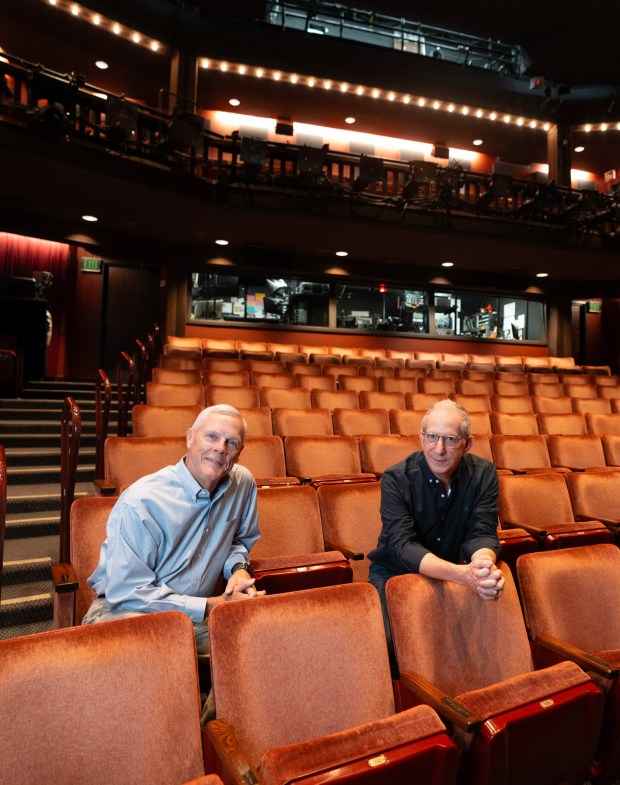 Old Globe Artistic Director Barry Edelstein (r) and Old Globe Managing Director Tim Shields (l) at the Old Globe on Friday, Oct. 3, 2025 in San Diego, CA. (Nelvin C. Cepeda / The San Diego Union-Tribune)
Old Globe Artistic Director Barry Edelstein (r) and Old Globe Managing Director Tim Shields (l) at the Old Globe on Friday, Oct. 3, 2025 in San Diego, CA. (Nelvin C. Cepeda / The San Diego Union-Tribune)
“Tim is the dean of theater managers in the United States,” Edelstein said. “He’s clearly exemplary and has transformed the place in ways the audience will never see in the internal systems he created, the hires he’s made and the changes in how we do business. The community of San Diego owes Tim Shields a great debt of gratitude and he’ll be tough to replace.”
Edelstein said philanthropic giving to the Globe hasn’t grown in recent years because patrons are redirecting their money to causes with more urgent needs, like the environment and medical research. But giving to the Globe hasn’t declined, either.
“There’s philanthropic enthusiasm for the Globe which makes me feel a little more optimistic,” Edelstein said. “Everyone likes a winner and there’s a lot of energy around the Old Globe right now. We’re investing in the future of the art form. It’s exciting to be around.”
A story in The New York Times last month reported that none of the 18 commercial musicals that opened on Broadway last season recouped their producers’ original investment, in part because production costs have skyrocketed. As a result, producers are now more skittish.
Edelstein has seen this first-hand, with far fewer musical scripts crossing his desk in recent years.
“The idea that we’re going to go to San Diego and give it a try and sink a lot of money into a show out of town, it’s harder for them to justify,” Edelstein said. “We’re seeing a reticence among commercial producers to even embark upon the venture.”
To fill the gap, Edelstein has been adding one or shows to his season schedules that are pre-built projects that can easily travel, including plays and musicals from Florida’s Asolo Repertory Theatre and cirque-style shows from Montreal’s The 7 Fingers troupe. Two such shows in the 2026 lineup are touring productions of the plays “Kim’s Convenience” and “North by Northwest.”
“They meet or exceed the level of excellence the audience has come to expect. That’ the key,” Edelstein said. “If we were to start finding cost-saving approaches that eroded the quality, then we’d be sunk.”
In the meantime, the Globe is developing its own plays in house through its Powers New Voices Festival.
“We’re now going in the other direction and saying we’re not going to wait for them to come to us. We’re going to develop stuff here and see if we can’t bring that out into the commercial theater world,” he said.
Shields said the Globe is in a different “mindset” than most theaters these days.
“The Globe isn’t in a moment where our thinking is about shrinking and how can we do less. Instead, our thinking is about how we can be more of service to the community and impact yet more people. I’m really proud of that,” Shields said.
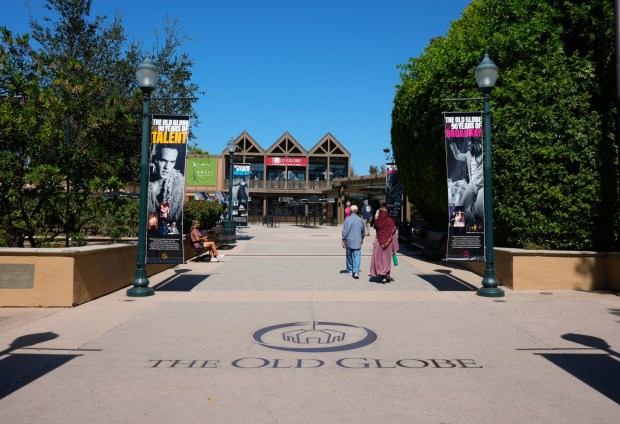 The walkway leading to The Old Globe campus in Balboa Park on Oct. 3, 2025. (Nelvin C. Cepeda / The San Diego Union-Tribune)
The walkway leading to The Old Globe campus in Balboa Park on Oct. 3, 2025. (Nelvin C. Cepeda / The San Diego Union-Tribune)
Looking toward 100
The Old Globe has not announced any major capital projects through 2035. But that doesn’t mean it’s resting on its laurels.
The city of San Diego has announced it will begin charging for parking in Balboa Park sometime in the next several months. The rates, hours and exclusions for theater and museum employees and San Diego city residents are still being determined.
“The Globe and other organizations in Balboa Park have not been shy in sharing our concerns,” Edelstein said.” We’ll continue to advocate about keeping Balboa Park as accessible as possible, but we don’t control that.”
Among the proposals being considered by the city would be an option of three hours of free parking at Inspiration Point (near the San Diego Veterans Museum) with expanded shuttle service from there to the central Plaza de Panama, enforcement hours ending at 8 p.m., and four-hour parking rates rather than daylong rates. Also, Globe staff and volunteers would be provided with free parking spaces outside the park’s central core.
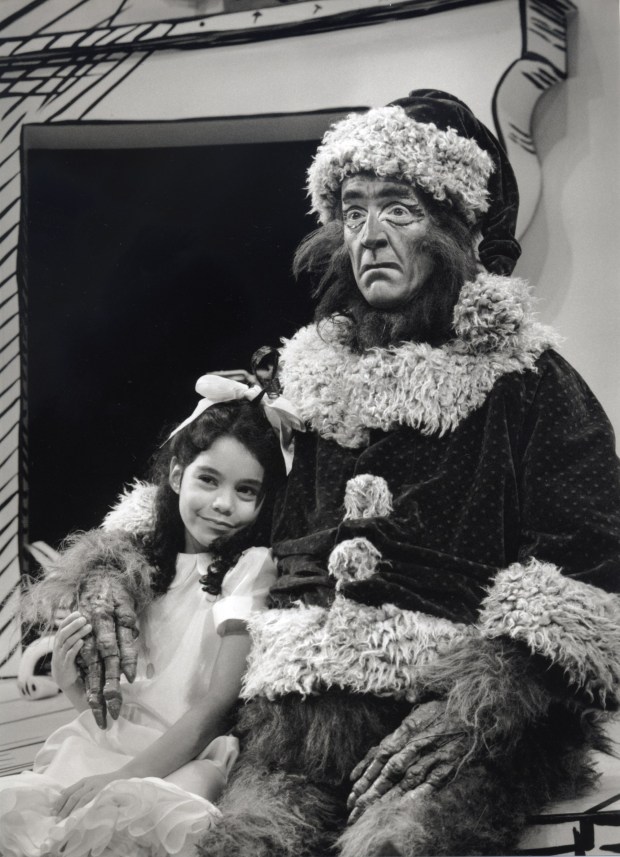 Vanessa A. Hudgens as Cindy-Lou Who and Guy Paul as the Grinch in The Old Globe’s inaugural 1998 production of “Dr. Seuss’s How the Grinch Stole Christmas!” The “Grinch” musical is now in its 27th year. (Ken Howard)
Vanessa A. Hudgens as Cindy-Lou Who and Guy Paul as the Grinch in The Old Globe’s inaugural 1998 production of “Dr. Seuss’s How the Grinch Stole Christmas!” The “Grinch” musical is now in its 27th year. (Ken Howard)
In happier future news, the Old Globe is expanding the life of its most popular theatrical product, “Dr. Seuss’s How the Grinch Stole Christmas!” musical, which has been presented every year since 1998, including in radio/podcast form during the pandemic.
Next month, the Globe will present the first musical reading of an in-development Spanish-language version of the show that it hopes to produce alongside the original in future years.
Jack O’Brien brought the “Grinch” to the Globe from a Minnesota children’s theater and, as director, he expanded and reimagined the show as a storybook comes to life. It’s now a huge box-office bonanza for the Globe, selling out most tickets within hours of going on sale each fall.
O’Brien said he’s very proud of the “Grinch” because it has the power to transform children into lifelong theater lovers.
“I was determined when we got it to put every single bit of theater craft I knew into that little show,” he said. “If I can bring a child to the theater for the first time and they see puppetry, music, cartoon people, black against black and all the tricks we know how to play, they will never be the same. I felt in an odd way it was a compendium of why you love to go to the theater.”
Also on Edelstein’s checklist for the coming years is an ongoing quest to continue raising the Globe’s profile among San Diego County residents who have yet to attend a show.
To increase public awareness and visibility in recent years, the Globe has revamped its Balboa Park campus to make it more inviting to passers-by.
This includes free AXIS community events for all, a covered outdoor seating area with free WiFi access, a newly expanded menu at its walk-up Lady Carolyn’s Pub and better outdoor signage, banners and artwork, including the newly installed 90th anniversary sculpture on Copley Plaza.
“We have people here who think all day long about how can we engage more people on social media, in our marketing messaging and in our educational programming. That’s how you grow an institution around the art,” Edelstein said. “We are here to provide theater to the communities of San Diego. And that just simply has to expand and expand in as many ways as we possibly can.”

